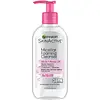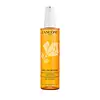Garnier SkinActive Micellar Foaming Cleanser Versus Lancôme Miel-En-Mousse Foaming Face Cleanser & Makeup Remover
What's inside
What's inside
 Key Ingredients
Key Ingredients

 Benefits
Benefits

 Concerns
Concerns

 Ingredients Side-by-side
Ingredients Side-by-side

Water
Skin ConditioningGlycerin
HumectantPEG-200 Hydrogenated Glyceryl Palmate
CleansingCoco-Betaine
CleansingSodium Laureth Sulfate
CleansingPolysorbate 20
EmulsifyingPEG-7 Glyceryl Cocoate
EmulsifyingCitric Acid
BufferingCocamide Mea
EmulsifyingPEG-55 Propylene Glycol Oleate
Polyquaternium-11
PPG-5-Ceteth-20
EmulsifyingPropylene Glycol
HumectantSodium Benzoate
MaskingSodium Chloride
MaskingSodium Hydroxide
BufferingVitis Vinifera
MaskingCeramide AP
Skin ConditioningWater, Glycerin, PEG-200 Hydrogenated Glyceryl Palmate, Coco-Betaine, Sodium Laureth Sulfate, Polysorbate 20, PEG-7 Glyceryl Cocoate, Citric Acid, Cocamide Mea, PEG-55 Propylene Glycol Oleate, Polyquaternium-11, PPG-5-Ceteth-20, Propylene Glycol, Sodium Benzoate, Sodium Chloride, Sodium Hydroxide, Vitis Vinifera, Ceramide AP
Glycerin
HumectantWater
Skin ConditioningSodium Laureth Sulfate
CleansingCoco-Betaine
CleansingPEG-7 Glyceryl Cocoate
EmulsifyingMel
EmollientCI 19140
Cosmetic ColorantSodium Chloride
MaskingSodium Benzoate
MaskingPEG-55 Propylene Glycol Oleate
Polyquaternium-7
Salicylic Acid
MaskingNelumbo Nucifera Flower Extract
Skin ConditioningLimonene
PerfumingLinalool
PerfumingPropylene Glycol
HumectantSorbitol
HumectantRosa Gallica Flower Extract
AstringentCitric Acid
BufferingPrunus Amygdalus Dulcis Oil
Skin ConditioningParfum
MaskingGlycerin, Water, Sodium Laureth Sulfate, Coco-Betaine, PEG-7 Glyceryl Cocoate, Mel, CI 19140, Sodium Chloride, Sodium Benzoate, PEG-55 Propylene Glycol Oleate, Polyquaternium-7, Salicylic Acid, Nelumbo Nucifera Flower Extract, Limonene, Linalool, Propylene Glycol, Sorbitol, Rosa Gallica Flower Extract, Citric Acid, Prunus Amygdalus Dulcis Oil, Parfum
 Reviews
Reviews

Ingredients Explained
These ingredients are found in both products.
Ingredients higher up in an ingredient list are typically present in a larger amount.
Citric Acid is an alpha hydroxy acid (AHA) naturally found in citrus fruits like oranges, lemons, and limes.
Like other AHAs, citric acid can exfoliate skin by breaking down the bonds that hold dead skin cells together. This helps reveal smoother and brighter skin underneath.
However, this exfoliating effect only happens at high concentrations (20%) which can be hard to find in cosmetic products.
Due to this, citric acid is usually included in small amounts as a pH adjuster. This helps keep products slightly more acidic and compatible with skin's natural pH.
In skincare formulas, citric acid can:
While it can provide some skin benefits, research shows lactic acid and glycolic acid are generally more effective and less irritating exfoliants.
Most citric acid used in skincare today is made by fermenting sugars (usually from molasses). This synthetic version is identical to the natural citrus form but easier to stabilize and use in formulations.
Read more about some other popular AHA's here:
Learn more about Citric AcidCoco-Betaine is the natural version of Cocamidopropyl Betaine. It is often derived from coconuts.
Coco-Betaine is a surfactant, meaning it helps remove dirt and oil from the skin.
Glycerin is already naturally found in your skin. It helps moisturize and protect your skin.
A study from 2016 found glycerin to be more effective as a humectant than AHAs and hyaluronic acid.
As a humectant, it helps the skin stay hydrated by pulling moisture to your skin. The low molecular weight of glycerin allows it to pull moisture into the deeper layers of your skin.
Hydrated skin improves your skin barrier; Your skin barrier helps protect against irritants and bacteria.
Glycerin has also been found to have antimicrobial and antiviral properties. Due to these properties, glycerin is often used in wound and burn treatments.
In cosmetics, glycerin is usually derived from plants such as soybean or palm. However, it can also be sourced from animals, such as tallow or animal fat.
This ingredient is organic, colorless, odorless, and non-toxic.
Glycerin is the name for this ingredient in American English. British English uses Glycerol/Glycerine.
Learn more about GlycerinPEG-55 Propylene Glycol Oleate isn't fungal acne safe.
Peg-7 Glyceryl Cocoate is created from polyethylene glycol and fatty acids from coconut oil.
It is a synthetic polymer with emulsifying and cleansing properties.
As an emulsifier, Peg-7 Glyceryl Cocoate prevents ingredients such as oils and water from separating. It also helps rinse away oils, dirt, and pollutants from skin.
Peg-7 Glyceryl Cocoate may not be fungal acne safe. It can also dry out skin.
Learn more about PEG-7 Glyceryl CocoatePropylene Glycol is an odorless, colorless liquid. As a humectant, it helps skin retain moisture. It also aids in delivering active ingredients.
Another role of this ingredient is preventing a product from melting or freezing. Propylene glycol also adds antimicrobrial properties to a product, elongating product lifespan.
This ingredient is considered an organic alcohol and commonly added into both cosmetics and foods.
Those with sensitive skin or conditions may develop a rash when using this ingredient.
Learn more about Propylene GlycolSodium Benzoate is a preservative. It's used in both cosmetic and food products to inhibit the growth of mold and bacteria. It is typically produced synthetically.
Both the US FDA and EU Health Committee have approved the use of sodium benzoate. In the US, levels of 0.1% (of the total product) are allowed.
Sodium benzoate works as a preservative by inhibiting the growth of bacteria inside of cells. It prevents the cell from fermenting a type of sugar using an enzyme called phosphofructokinase.
It is the salt of benzoic acid. Foods containing sodium benzoate include soda, salad dressings, condiments, fruit juices, wines, and snack foods.
Studies for using ascorbic acid and sodium benzoate in cosmetics are lacking, especially in skincare routines with multiple steps.
We always recommend speaking with a professional, such as a dermatologist, if you have any concerns.
Learn more about Sodium BenzoateChances are, you eat sodium chloride every day. Sodium Chloride is also known as table salt.
This ingredient has many purposes in skincare: thickener, emulsifier, and exfoliator.
You'll most likely find this ingredient in cleansers where it is used to create a gel-like texture. As an emulsifier, it also prevents ingredients from separating.
There is much debate on whether this ingredient is comedogenic. The short answer - comedogenic ratings don't tell the whole story. Learn more about comegodenic ratings here.
The concensus about this ingredient causing acne seems to be divided. Research is needed to understand if this ingredient does cause acne.
Scrubs may use salt as the primary exfoliating ingredient.
Learn more about Sodium ChlorideSodium Laureth Sulfate (SLES) is a foaming, cleansing, and emulsifying ingredient. It is created from palm kernel oil or coconut oil. SLES is not the same as sodium lauryl sulfate. It is much milder and less likely to irritate.
SLES helps create foam in personal products. It also prevents ingredients from separating, helping to elongate the shelf life.
Sodium Laureth Sulfate is a type of sulfate. It can be drying. We recommend speaking with a professional about using this ingredient if you have concerns.
Learn more about Sodium Laureth SulfateWater. It's the most common cosmetic ingredient of all. You'll usually see it at the top of ingredient lists, meaning that it makes up the largest part of the product.
So why is it so popular? Water most often acts as a solvent - this means that it helps dissolve other ingredients into the formulation.
You'll also recognize water as that liquid we all need to stay alive. If you see this, drink a glass of water. Stay hydrated!
Learn more about Water